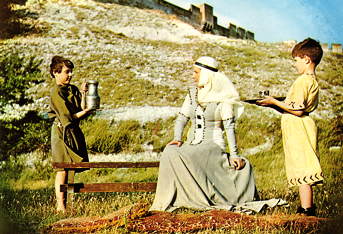Chūsei no Kishi
From the back of Chūsei no Kishi 中世の騎士 ("Knight of the Middle Ages"), a 1962 "true-to-life book" from Encyclopædia Britannica:

Rough translation of the blurb: "Our children, born into a changing society, destined to live in the world of tomorrow. As the world grows smaller and our society more international, what they need is the right skills to deal with this internationalization! To answer this call we have developed the content-rich Britannica Education Program. As a comprehensive educational enterprise, Britannica will continue striving to develop the people needed for the coming new age." You think they emphasized internationalization that much in the English version? Also, note that that kid on the right has a hipster haircut almost half a century ahead of schedule. Talk about prepared for the society of tomorrow.
Chūsei no Kishi is quite hardcore for a kid's book. The text by Dorothy Welker, "a former lecturer at the University of Chicago ... [who] has made a special study of medieval life" is presented in both English and Japanese, courtesy of "typographical adaptation" by "Peter Brogren at the Voyagers' Press, Tokyo." The photographs are from "the educational motion picture 'The Medieval Knights,' produced for Encyclopaedia [Sic!] Britannica Films inc. by Milan Herzog"!
In fact, The Medieval Knights might well have been one of "his Medieval films from the early 1950s [which] were among the first academic historical films to use costumed actors" mentioned at that last link. The film itself doesn't seem to be online, but Herzog's Je Parle Français is, and worth checking out. ("Elle est charmante," says one character to another as they watch their new lady friend leave. "Oui... charmante," comes the reply. They savor the view for a few more seconds before the scene changes.)
Here is one of the many stills from Herzog's film that are included in the book:

This apparently constitutes "learning how to behave courteously," although sitting on a bench so far from the castle in medieval times is just asking to be eaten by a bear and/or wyrm, as I understand it.
![[No-sword]](http://no-sword.jp/images/site/no-sword_banner.jpg)


